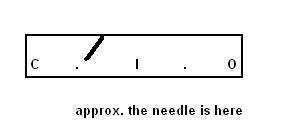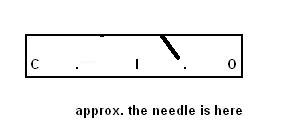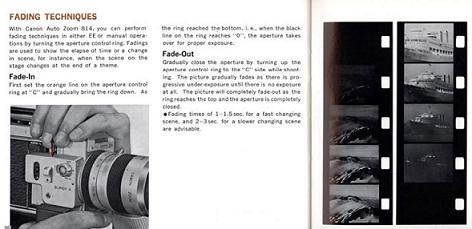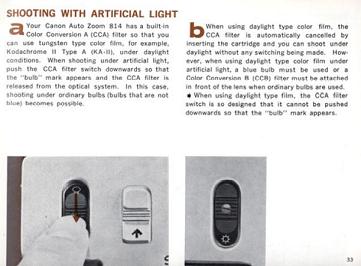This is topic Canon Autozoom 814 in forum 8mm Forum at 8mm Forum.
To visit this topic, use this URL:
https://8mmforum.film-tech.com/cgi-bin/ubb/ultimatebb.cgi?ubb=get_topic;f=1;t=005082
Posted by Christian Bjorgen (Member # 1780) on December 17, 2009, 09:20 AM:
So, I bought a Canon Autozoom, got all my spares as well as some reels of Ektachrome today, but I can't seem to get the exposure meter working. It just sits at the red bottom level until manually close the exposure, which sends it gradually to the top (Closed).
Any ideas?
Posted by Antonis Galanakis (Member # 1455) on December 17, 2009, 02:29 PM:
It is very easy. Just press a little the "rec" black button and it will work. Not all the way. By pressing it all the way rec, motor and meter work all together. Otherway you have a broken meter.
Hope that this answer will help.
Antonis
PS Do not forget to place the four AA batteries first.
Posted by Christian Bjorgen (Member # 1780) on December 17, 2009, 03:15 PM:
By "Rec" button, do you mean the switch that exposes the film and records?
All batteries are included.
Reading the manual now, and I'm wondering, does the meter only work when film is inserted?
Posted by John Clancy (Member # 49) on December 17, 2009, 04:09 PM:
Of course, the lithium battery could be dead.
Posted by Christian Bjorgen (Member # 1780) on December 17, 2009, 04:38 PM:
I just replaced all the batteries, and the seller said everything was working when he used the camera last (4-5 years ago).
Is it possible to shoot without the meter working?
Posted by Winbert Hutahaean (Member # 58) on December 17, 2009, 07:48 PM:
quote:
Is it possible to shoot without the meter working?
Hi Christian,
If you switch your camera to auto (exposure), basically you can shoot with it (although some pro-cameraman say the exposure will read E64T wrongly, but I don't see any big different).
Just do one test reel. If you see that the color is a bit bluish try to use external 85B filter (but don't forget to open the internal 85 filter built in inside your camera)
happy shooting,
Posted by John Clancy (Member # 49) on December 18, 2009, 04:37 AM:
I'd suggest setting the exposure manually. I got caught out with dead batteries years ago and have exactly the symptoms you describe. The reel I shot was a write-off.
Posted by Christian Bjorgen (Member # 1780) on December 18, 2009, 07:04 AM:
Do you mean setting it to manual and using the "C-O" switch to adjust?
Posted by Winbert Hutahaean (Member # 58) on December 18, 2009, 09:10 AM:
quote:
I got caught out with dead batteries years ago
How can you guys shooting with dead batteries ![[Confused]](confused.gif)
![[Confused]](confused.gif)
Knowing the film cartridge will only work with good batteries?
What my understanding was Christian has a camera with non-working exposure meter but certainly he has to have good batteries to play with the camera.
Christian, sometime auto-exposure camera get broken on meter but still working to close and open the auto exposure. So only the meter is broken.
I get one with this condition, but keep shooting with auto switched and get a good result.
cheers,
Posted by Christian Bjorgen (Member # 1780) on December 18, 2009, 09:32 AM:
The problem is that the meter doesnt measure exposure, the needle only moves when I manually change the exposure.
All the batteries are brand new.
Posted by Claus Harding (Member # 702) on December 18, 2009, 09:47 AM:
Christian,
You would need to measure manually with an external lightmeter and then set it on the camera. This is assuming that that camera actually shows you f-stop numbers in the viewfinder and not just a generic 'scale'; otherwise you have nothing to match the exposure to.
Claus.
Posted by Christian Bjorgen (Member # 1780) on December 18, 2009, 10:23 AM:
Hi, Claus!
I don't know the difference between exposure meters I'm afraid.
Here's the manual for the camera:
http://www.jamesvanarsdale.com/links/canonsuper8/CanonAZ814Super8Manual.pdf
You can see pictures and read alot about the exposure meter and its functions there.
Posted by Winbert Hutahaean (Member # 58) on December 18, 2009, 10:07 PM:
Christian,
I am shooting Ektachrome 64T just for fun, nothing pro or serious with that. So my experience is mostly taking part in the explanation below.
If you can set the exposure manually and you will see the needle moves between close and open when you play with it, it means you are basically can shoot with this camera.
My advise is to play save by taking as many as possible outdoor scenes. When the sun is very bright and yo have a clear sky (no clouds) set the meter 1/4 between C and O.

If you are shooting during cloudy days, increase the exposure to O (open) to almost 3/4.

Never shooting in the dark (night) if you don't have a specially designed lighting for shooting (500 watt to 1000 watt). E64T will not capture anything although you fully open the exposure.
If you read the below section on your manual, you will understand the function of C and O on manual setting.

It is basically to close or to open the exposure. In other words to decrease/increase light coming into your camera.
If you are shooting in indoor (inside a house), please do only during daytime where sunlight can come into the house and set the exposure to fully open.
However if you have a proper lighting (as I mentioned above) for indoor shooting or dark scenes, you can set the exposure manually between 1/2 and 3/4.
But don't forget to release the internal filter (see the bulb sign). Otherwise you will get too warmth (red) in the tone color due to the lighting used. Read this section:

(ps: I have a feeling that your auto exposure is actually working but only the needles is broken in auto setting, just do a couple second testing in your cartridge. Set it to auto and do shooting indoor and outdoor during daytime. And see what is the result. Canon is the best camera).
[UPDATE: Accidentally I read page 13 of the manual you sent above and it reads: "BE sure that the three-way switch is set at "R". Other wise the needle meter will not move". Do you think this might be the reason for your problem?)
Have a good shooting,
Posted by Christian Bjorgen (Member # 1780) on December 19, 2009, 05:18 PM:
The switch is set to "R", but I'm thinking that the battery chamber might be broken. Anyway, most of the shooting will be done in my living room, where it's pretty well lit, so I don't think it will be a problem.
You say that I should do a few seconds of testing with auto exposure, how will I know that it works?
Posted by Winbert Hutahaean (Member # 58) on December 19, 2009, 10:11 PM:
quote:
where it's pretty well lit, so I don't think it will be a problem.
Well, domestic (house) lamps will not help anything to Ektachrome 64T. You have to have a special designed lighting for indoor shooting (500w to 1000 watt bulb).
quote:
I'm thinking that the battery chamber might be broken.
This is always my question why you guys talking dead batteries or battery chamber broken when working with electric camera. Practically you cannot do any shooting if you have the battery chamber broken. Simply how can the camera turn the cartridge without a power??
So can you tell me, with the batteries are inside the chamber, can you push the rec button and see if the cartridge chamber turning? If you can see it is turning, so there is no a problem with your battery chamber.
quote:
You say that I should do a few seconds of testing with auto exposure, how will I know that it works?
Since this is your first shooting with 8mm and your first experience you have to know the characteristic of your machine. Well, the only way is to sacrifice one cartridge and get processed.
OK this is not a cheap strategy since the cartridge, lab process and shipping are not cheap though. So, that is why my first advise above is to suggest you to shoot as many as possible outdoor scene during daytime. You are pretty well saved by the sunlight. After shooting your important subjet, don't forget to leave few seconds for test reel for indoor shooting, play with your "C and O" switch, etc
cheers,
Posted by Christian Bjorgen (Member # 1780) on December 20, 2009, 03:20 AM:
Winbert, there are two seperate battery chambers:
One for the motor and zoom functions, and one for the exposure meter. I'm thinking that the latter one could be broken, because it's the only function that doesnt work. Either that or I'm doing something wrong. Or it could be the needle of course.
In terms of shooting, won't even very bright household lights do? I'm talking about a living room with 10 crazy spotlights in the roof here ![[Wink]](wink.gif) The "important subject" is indoors at night you see :/
The "important subject" is indoors at night you see :/
Posted by Winbert Hutahaean (Member # 58) on December 20, 2009, 08:56 AM:
quote:
Winbert, there are two seperate battery chambers:
One for the motor and zoom functions, and one for the exposure meter.
Hi Christian,
I am sorry, I didn't know thee are 2 separate battery chambers. If so, then you might be right.
Btw, as far as I remember, when I have your older brother camera (Canon 1014 XL), there was only one chamber.
quote:
In terms of shooting, won't even very bright household lights do? I'm talking about a living room with 10 crazy spotlights in the roof here
Then you have to have an external exposure meter like Claus mentiones above.
The thing with an external meter, then you have to calculate it with the sensitivity of E64T. In this regard, this issue is going to be explained by more pro-users, which I am not.
I can only talk through My experience.
Now, although you have 10 spotlights, there are several items you have to consider:
1. What is the wattage of each lamps. If it is 50w each then the total is not necessarily 500w because the 10 lights normally spread in different points.
2. How tall are lights placed. The taller is they are, the dimmer is received on surface.
3. Are they tungsten (incandescent) lights or save energy lights (neon bulb)? because save energy lights always look bright to our eyes but not to Ektachrome.
Fyi, as written on the box,Ektachrome 64T is ASA 64 for indoor use with lighy and ASA 40 for outdoor.
You have to use 200T for a successful indoor shooting with household lights. Check on youtube, there are couple test reel results for 64T and 200T indoor and outdoor shooting with Canon Camera.
cheers,
Posted by Christian Bjorgen (Member # 1780) on December 20, 2009, 09:06 AM:
OK!
Are these exposure meters hard to find or/and expensive?
Posted by Winbert Hutahaean (Member # 58) on December 20, 2009, 09:27 AM:
No, I think it is not expensive.
(probably) you can also use the exposure meter installed in old 35mm camera (still film), if you have it. But again, I don't know to read the exposure meter against the sensitivity of E64T.
Just share my experience, during my wife's labor (I was trying to capture my baby). You can imagine how bright is the surgery room. But when I got my E64T back from the lab, it was pretty well dark!.
Lucky me that right my baby came out from the tummy, doctor used incandescent spot light (surgery lab) whichnwas enough to capture my baby's face.
The image on the screen was so unique now because everything was seen dark, only a baby spotted in the middle od darkness. he...he..he...
Posted by Christian Bjorgen (Member # 1780) on December 20, 2009, 09:44 AM:
Well, the living room isnt THAT bright ![[Wink]](wink.gif)
But most of the old reels I have from my grandparents are, according to my great aunt who filmed most of them, Kodachrome 40, and was shot in what she called "normal houselights".
These are all decent films, albeit a little dark.
Posted by Winbert Hutahaean (Member # 58) on December 20, 2009, 09:52 AM:
quote:
But most of the old reels I have from my grandparents are, according to my great aunt who filmed most of them, Kodachrome 40, and was shot in what she called "normal houselights".
These are all decent films, albeit a little dark.
Christian, I don't know if there is a Lab issue in this regard.
I should say that my old Kodachrome 40 from 1970s/80s look much better that the newer stock and processed in 2000.
So, this has to be answered by pro-users (and much proper answered at http://www.filmshooting.com/scripts/forum/. Many of our members here are also there. The filmshooting.com is as friendly as this forum, but they are talking about home-movies rather than packed-movies like we are here.
cheers,
Posted by Christian Bjorgen (Member # 1780) on December 20, 2009, 12:07 PM:
OK, I checked the pricings on exposure meters now, they start at 50-100$ which is a bit expensive for me.
I guess I'll have to try with autoexposure and see what happens ![[Smile]](smile.gif)
---
Update:
OK, so I've red abit about exposure meters and such now, and if I'm not wrong, the auto exposure meter won't work BEFORE I insert a cartridge, because the camera needs to recognize the film type before it can set the correct exposure.
Posted by Winbert Hutahaean (Member # 58) on December 20, 2009, 12:58 PM:
Christian, below is the list of test reel on youtube:
http://www.youtube.com/results?search_query=Canon+814+Ektachrome+&search_type=&aq=f
And this is the most useful one because it shows a camera Canon 814 with E64T during indoors shooting (with 500w movie lighting tungsten).
http://www.youtube.com/watch?v=iY5bX1xjAJY
He is using manual exposure and the exposure meter is shown there. So at least you can guess how you have to deal with your camera.
cheers and happy shooting.
Posted by Christian Bjorgen (Member # 1780) on December 20, 2009, 03:53 PM:
Wow, that video gave me alot of insight, thanks ![[Wink]](wink.gif)
I also checked some of the other videoes, and I believe if I use an extra lamp for the shooting, it should work just fine ![[Smile]](smile.gif)
One question tho, what does the F1, F5, F9 etc. in the video mean?
Posted by Robert Lewis (Member # 1458) on December 20, 2009, 05:02 PM:
Hi Christian.
I came across your posting about the difficulty you are having with the exposure meter on your Canon 814 Autozoom.
I have the model which followed yours, the 814 Autozoom E.
Both cameras have very good reputations, but there are significant differences between them. As you have said, your model requires batteries specifically for the exposure meter, and two 1.3v mercury cells are required and these must be fitted the correct way. You say you have replaced them, but the original type of cell are no longer available.
My camera does not require these because the 814 Autozoom E takes a feed from the four main batteries.
From what you say, I am not sure whether you have managed to replace the two exposure meter cells, but certainly the exposure meter will not work without them. Assuming you have replaced the cells with the modern replacements, and checked that the contacts are clean, you need to set the exposure switch to "auto" and the main power switch to "R". I believe that on your model there is a white button you can press to check whether the exposure meter cells are sufficiently powerful.
Assuming you have power for the exposure meter, try setting the meter to manual operation. Then as you turn the control wheel, you should see the "needle" in the viewfinder moving. If it does move, that indicates that the coupling to the needle itself is working. If it does not move, it suggests that the coupling has failed in some way. It may be that the auto exposure system will work even though the needle is not moving, and the only way to establish that is to try a test film.
Finally Ektachrome 64t, being a reversal stock, is exposure critical. Also, it is quite a "slow" stock and these two factors mean that you must have adequate light. Otherwise your film will be very disappointing.
I hope you will find this helpful, but if I am just taking you through what you have already done, please accept my apologies.
Posted by Jim Carlile (Member # 812) on December 20, 2009, 09:30 PM:
Doesn't the early 814 have a mechanically-linked manual exposure wheel? If so, you don't need batteries to use it-- or even a functioning meter! Just turn the dial.
Posted by Winbert Hutahaean (Member # 58) on December 21, 2009, 07:48 AM:
quote:
Doesn't the early 814 have a mechanically-linked manual exposure wheel? If so, you don't need batteries to use it-- or even a functioning meter! Just turn the dial.
Yes Jim, Christian is aware with this function and he know the manual exposure to switch between C (close) and O (open). The problem is Christian does not understand how Close or Open he has to set during indoor shooting (without a movie lighting)
quote:
One question tho, what does the F1, F5, F9 etc. in the video mean?
Sorry Christian, I don't know either. I am making film just for fun, but I can see that if the more open is exposure set the more light come into camera (which means can help you in indoor shooting with minimum lighting. However, it can also be over exposure if too much light coming)
cheers
Posted by Christian Bjorgen (Member # 1780) on December 21, 2009, 03:47 PM:
I managed to fix the auto exposure now, turns out that the wire running from the battery chamber to the meter was teared, so I opened the camera and fixed it. Now it works like a charm!
I'm getting decent readings on the meter in the living room, so I think I'll be fine ![[Smile]](smile.gif)
Posted by Winbert Hutahaean (Member # 58) on December 21, 2009, 04:00 PM:
Good job Christian,
Would you kindly post on youtube once you finished your work please. So I can also figure it out how I can do indoor shooting without a movie lighting. We are all learning here.
cheers,
Posted by Winbert Hutahaean (Member # 58) on December 22, 2009, 01:02 PM:
quote:
I'm getting decent readings on the meter in the living room, so I think I'll be fine [Smile]
Hi Christian, it just came to my mind that you might misinterpret the meter.
On my camera, if the meter moves from C to O and finally sits at full "O", it does mean the camera needs much light (hence open fully the exposure).
So if you have done testing with the camera for indoor shooting and the meter points the numbers between C and O, you are pretty well saved in terms of lighting.
However if it reads at full "O", BEWARE it can also be understood that there is not enough light (so that's why the exposure/iris is fully open).
(ps: Remember that the meter between C and O does not show how intense is the light in the room but it shows how close/open is the exposure/iris)
Posted by Christian Bjorgen (Member # 1780) on December 22, 2009, 03:09 PM:
I will upload the film to YouTube once I have it processed and digitalized.
The needle is on 3/4 to 5/6 when I'm using the spotlights in the roof, but when I use the floor lamps aswell, it goes to about 1/2 on the meter, so I think I should be fine.
Visit www.film-tech.com for free equipment manual downloads. Copyright 2003-2019 Film-Tech Cinema Systems LLC

UBB.classicTM
6.3.1.2
![[Confused]](confused.gif)
![[Confused]](confused.gif)
![[Wink]](wink.gif) The "important subject" is indoors at night you see :/
The "important subject" is indoors at night you see :/
![[Wink]](wink.gif)
![[Smile]](smile.gif)
![[Wink]](wink.gif)
![[Smile]](smile.gif)
![[Smile]](smile.gif)